A Literature Review of Bullying and Harassment in Healthcare
VerifiedAdded on 2023/06/14
|11
|2589
|337
Literature Review
AI Summary
This literature review examines bullying and harassment as significant occupational health issues within the healthcare sector, focusing on their manifestation, consequences, and relevant legislative requirements. It uses the Australasian College for Emergency Medicine (ACEM) as a case study to illustrate the prevalence of bullying, including abusive language, intimidation, and humiliation, often perpetrated by senior staff against junior colleagues. The review highlights the detrimental effects of bullying, such as stress, psychological illness, and emotional distress, which can lead to decreased job satisfaction and potential physical health implications. Furthermore, it discusses the existing legislative frameworks in Australia, like the Work Health and Safety Regulation 2011 and Safe Work Australia regulation of 2014, designed to minimize workplace bullying, along with standard industry practices, including the establishment of health safety policies and the implementation of bullying reports. The review concludes by emphasizing the need for continued efforts to address and mitigate bullying and harassment to foster healthier and safer healthcare workplaces.
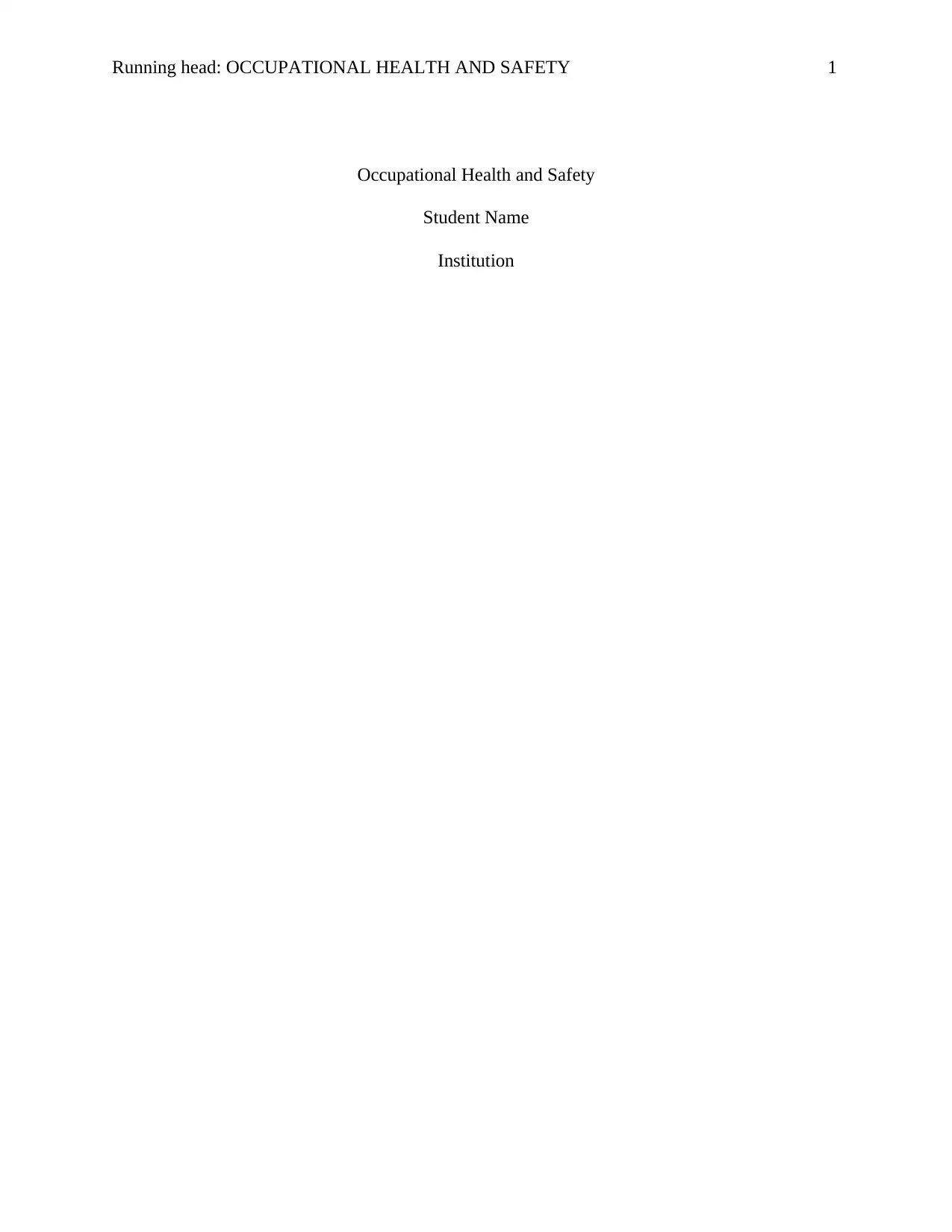
Running head: OCCUPATIONAL HEALTH AND SAFETY 1
Occupational Health and Safety
Student Name
Institution
Occupational Health and Safety
Student Name
Institution
Paraphrase This Document
Need a fresh take? Get an instant paraphrase of this document with our AI Paraphraser
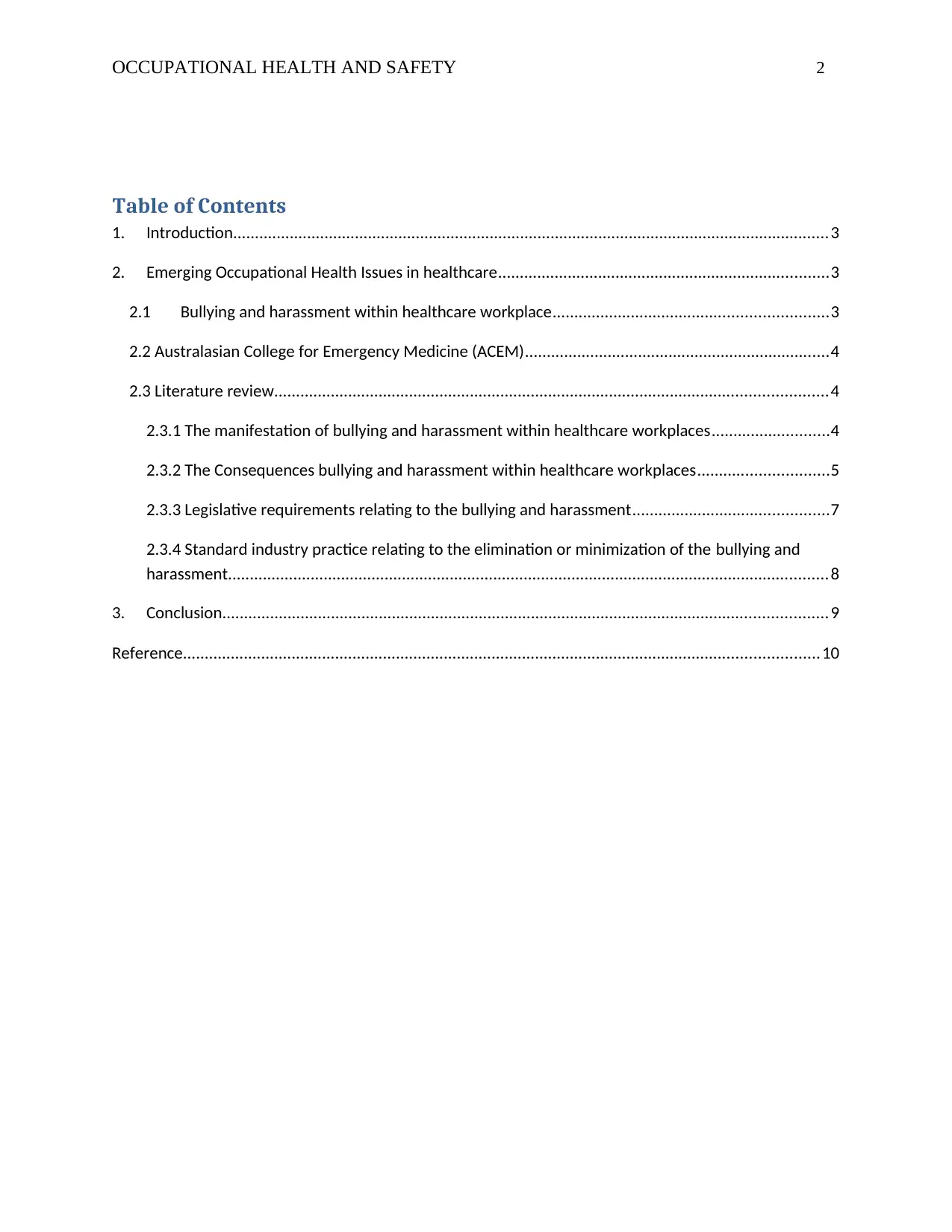
OCCUPATIONAL HEALTH AND SAFETY 2
Table of Contents
1. Introduction.........................................................................................................................................3
2. Emerging Occupational Health Issues in healthcare............................................................................3
2.1 Bullying and harassment within healthcare workplace...............................................................3
2.2 Australasian College for Emergency Medicine (ACEM)......................................................................4
2.3 Literature review...............................................................................................................................4
2.3.1 The manifestation of bullying and harassment within healthcare workplaces...........................4
2.3.2 The Consequences bullying and harassment within healthcare workplaces..............................5
2.3.3 Legislative requirements relating to the bullying and harassment.............................................7
2.3.4 Standard industry practice relating to the elimination or minimization of the bullying and
harassment..........................................................................................................................................8
3. Conclusion...........................................................................................................................................9
Reference..................................................................................................................................................10
Table of Contents
1. Introduction.........................................................................................................................................3
2. Emerging Occupational Health Issues in healthcare............................................................................3
2.1 Bullying and harassment within healthcare workplace...............................................................3
2.2 Australasian College for Emergency Medicine (ACEM)......................................................................4
2.3 Literature review...............................................................................................................................4
2.3.1 The manifestation of bullying and harassment within healthcare workplaces...........................4
2.3.2 The Consequences bullying and harassment within healthcare workplaces..............................5
2.3.3 Legislative requirements relating to the bullying and harassment.............................................7
2.3.4 Standard industry practice relating to the elimination or minimization of the bullying and
harassment..........................................................................................................................................8
3. Conclusion...........................................................................................................................................9
Reference..................................................................................................................................................10
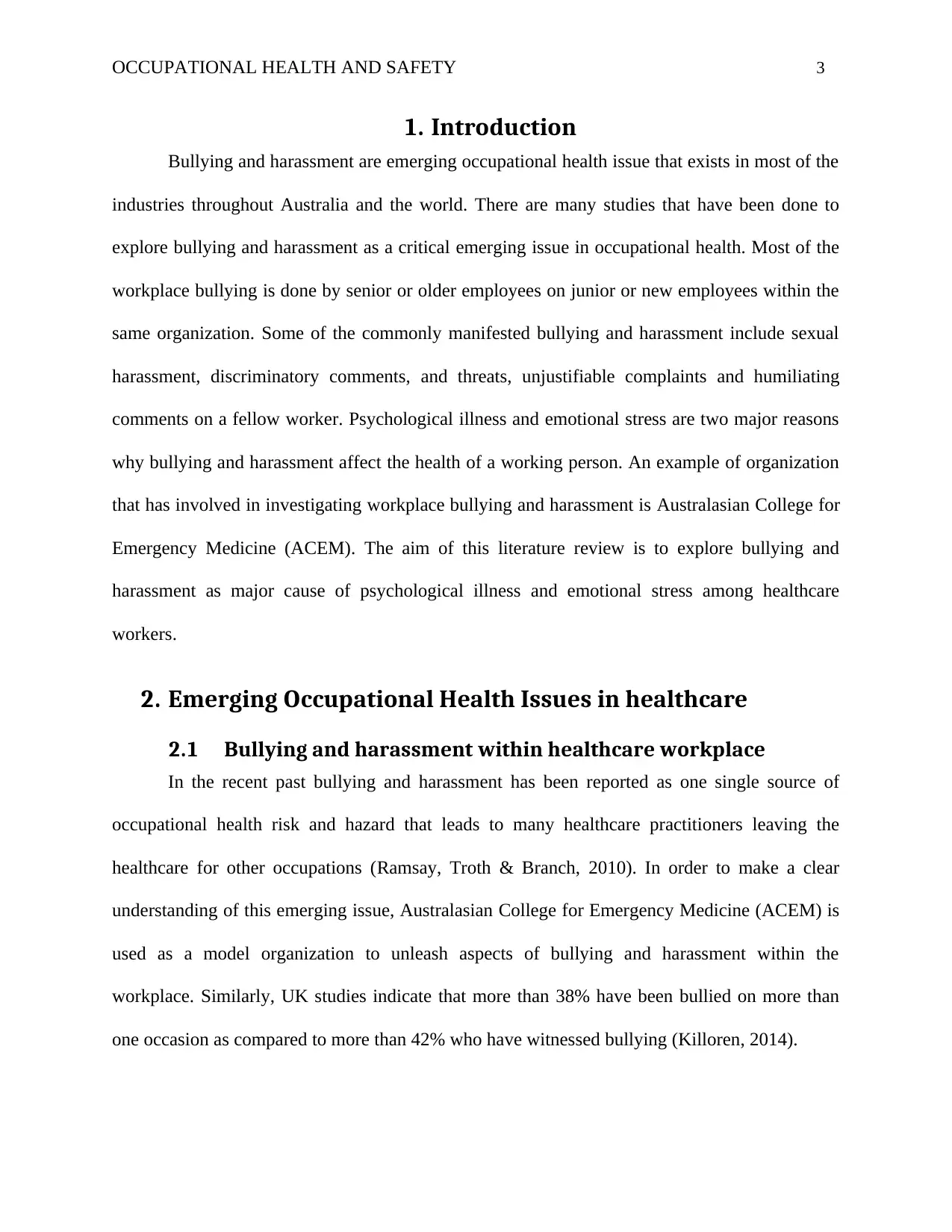
OCCUPATIONAL HEALTH AND SAFETY 3
1. Introduction
Bullying and harassment are emerging occupational health issue that exists in most of the
industries throughout Australia and the world. There are many studies that have been done to
explore bullying and harassment as a critical emerging issue in occupational health. Most of the
workplace bullying is done by senior or older employees on junior or new employees within the
same organization. Some of the commonly manifested bullying and harassment include sexual
harassment, discriminatory comments, and threats, unjustifiable complaints and humiliating
comments on a fellow worker. Psychological illness and emotional stress are two major reasons
why bullying and harassment affect the health of a working person. An example of organization
that has involved in investigating workplace bullying and harassment is Australasian College for
Emergency Medicine (ACEM). The aim of this literature review is to explore bullying and
harassment as major cause of psychological illness and emotional stress among healthcare
workers.
2. Emerging Occupational Health Issues in healthcare
2.1 Bullying and harassment within healthcare workplace
In the recent past bullying and harassment has been reported as one single source of
occupational health risk and hazard that leads to many healthcare practitioners leaving the
healthcare for other occupations (Ramsay, Troth & Branch, 2010). In order to make a clear
understanding of this emerging issue, Australasian College for Emergency Medicine (ACEM) is
used as a model organization to unleash aspects of bullying and harassment within the
workplace. Similarly, UK studies indicate that more than 38% have been bullied on more than
one occasion as compared to more than 42% who have witnessed bullying (Killoren, 2014).
1. Introduction
Bullying and harassment are emerging occupational health issue that exists in most of the
industries throughout Australia and the world. There are many studies that have been done to
explore bullying and harassment as a critical emerging issue in occupational health. Most of the
workplace bullying is done by senior or older employees on junior or new employees within the
same organization. Some of the commonly manifested bullying and harassment include sexual
harassment, discriminatory comments, and threats, unjustifiable complaints and humiliating
comments on a fellow worker. Psychological illness and emotional stress are two major reasons
why bullying and harassment affect the health of a working person. An example of organization
that has involved in investigating workplace bullying and harassment is Australasian College for
Emergency Medicine (ACEM). The aim of this literature review is to explore bullying and
harassment as major cause of psychological illness and emotional stress among healthcare
workers.
2. Emerging Occupational Health Issues in healthcare
2.1 Bullying and harassment within healthcare workplace
In the recent past bullying and harassment has been reported as one single source of
occupational health risk and hazard that leads to many healthcare practitioners leaving the
healthcare for other occupations (Ramsay, Troth & Branch, 2010). In order to make a clear
understanding of this emerging issue, Australasian College for Emergency Medicine (ACEM) is
used as a model organization to unleash aspects of bullying and harassment within the
workplace. Similarly, UK studies indicate that more than 38% have been bullied on more than
one occasion as compared to more than 42% who have witnessed bullying (Killoren, 2014).
⊘ This is a preview!⊘
Do you want full access?
Subscribe today to unlock all pages.

Trusted by 1+ million students worldwide
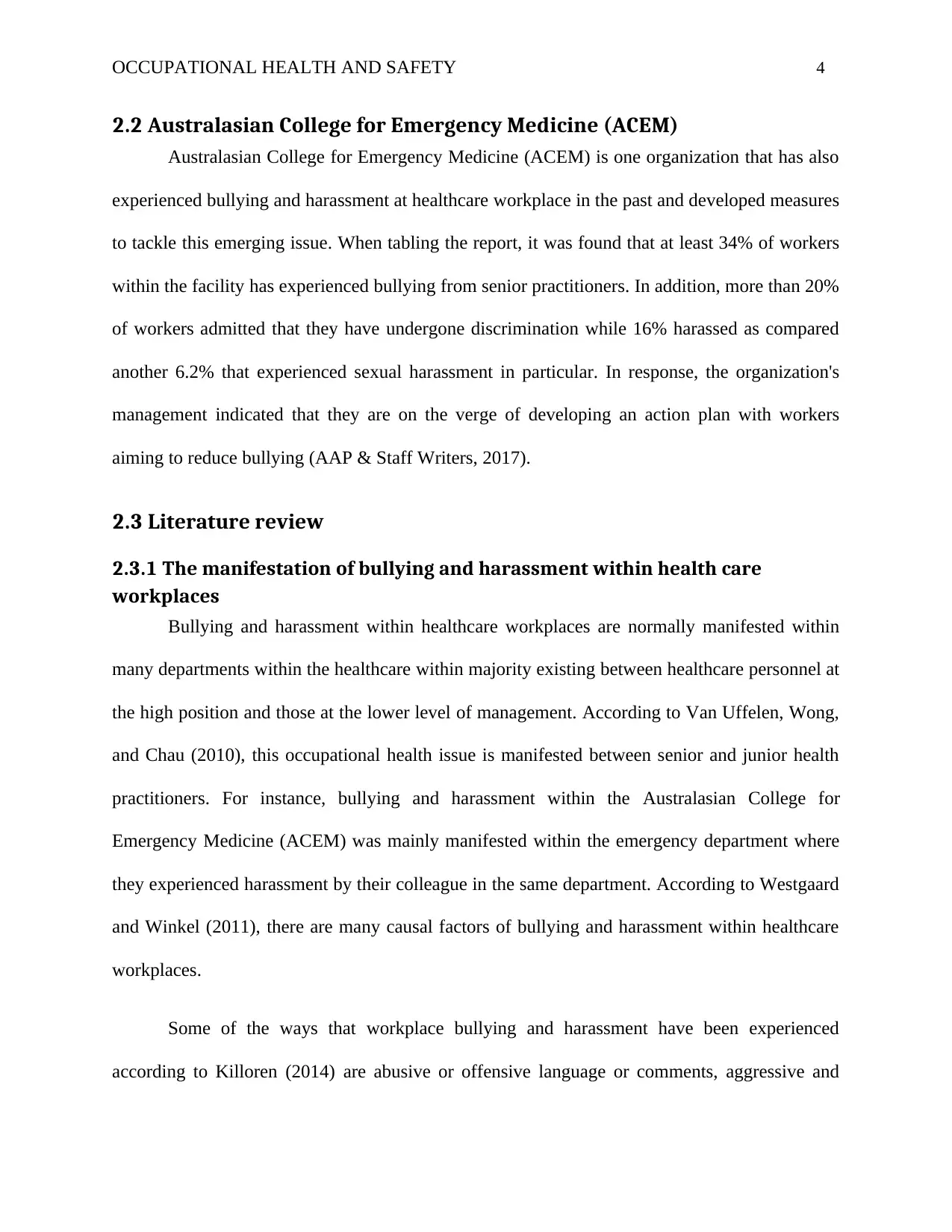
OCCUPATIONAL HEALTH AND SAFETY 4
2.2 Australasian College for Emergency Medicine (ACEM)
Australasian College for Emergency Medicine (ACEM) is one organization that has also
experienced bullying and harassment at healthcare workplace in the past and developed measures
to tackle this emerging issue. When tabling the report, it was found that at least 34% of workers
within the facility has experienced bullying from senior practitioners. In addition, more than 20%
of workers admitted that they have undergone discrimination while 16% harassed as compared
another 6.2% that experienced sexual harassment in particular. In response, the organization's
management indicated that they are on the verge of developing an action plan with workers
aiming to reduce bullying (AAP & Staff Writers, 2017).
2.3 Literature review
2.3.1 The manifestation of bullying and harassment within health care
workplaces
Bullying and harassment within healthcare workplaces are normally manifested within
many departments within the healthcare within majority existing between healthcare personnel at
the high position and those at the lower level of management. According to Van Uffelen, Wong,
and Chau (2010), this occupational health issue is manifested between senior and junior health
practitioners. For instance, bullying and harassment within the Australasian College for
Emergency Medicine (ACEM) was mainly manifested within the emergency department where
they experienced harassment by their colleague in the same department. According to Westgaard
and Winkel (2011), there are many causal factors of bullying and harassment within healthcare
workplaces.
Some of the ways that workplace bullying and harassment have been experienced
according to Killoren (2014) are abusive or offensive language or comments, aggressive and
2.2 Australasian College for Emergency Medicine (ACEM)
Australasian College for Emergency Medicine (ACEM) is one organization that has also
experienced bullying and harassment at healthcare workplace in the past and developed measures
to tackle this emerging issue. When tabling the report, it was found that at least 34% of workers
within the facility has experienced bullying from senior practitioners. In addition, more than 20%
of workers admitted that they have undergone discrimination while 16% harassed as compared
another 6.2% that experienced sexual harassment in particular. In response, the organization's
management indicated that they are on the verge of developing an action plan with workers
aiming to reduce bullying (AAP & Staff Writers, 2017).
2.3 Literature review
2.3.1 The manifestation of bullying and harassment within health care
workplaces
Bullying and harassment within healthcare workplaces are normally manifested within
many departments within the healthcare within majority existing between healthcare personnel at
the high position and those at the lower level of management. According to Van Uffelen, Wong,
and Chau (2010), this occupational health issue is manifested between senior and junior health
practitioners. For instance, bullying and harassment within the Australasian College for
Emergency Medicine (ACEM) was mainly manifested within the emergency department where
they experienced harassment by their colleague in the same department. According to Westgaard
and Winkel (2011), there are many causal factors of bullying and harassment within healthcare
workplaces.
Some of the ways that workplace bullying and harassment have been experienced
according to Killoren (2014) are abusive or offensive language or comments, aggressive and
Paraphrase This Document
Need a fresh take? Get an instant paraphrase of this document with our AI Paraphraser
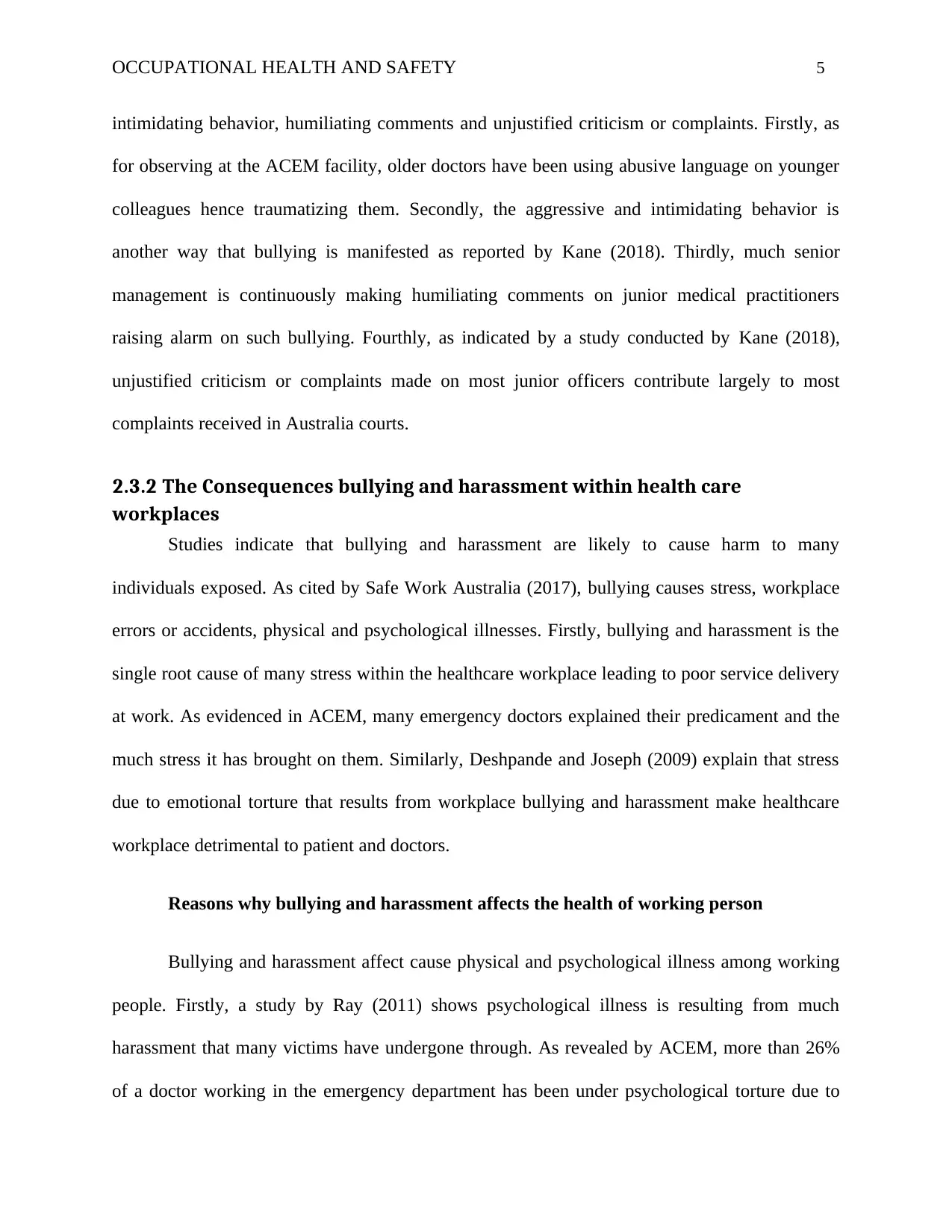
OCCUPATIONAL HEALTH AND SAFETY 5
intimidating behavior, humiliating comments and unjustified criticism or complaints. Firstly, as
for observing at the ACEM facility, older doctors have been using abusive language on younger
colleagues hence traumatizing them. Secondly, the aggressive and intimidating behavior is
another way that bullying is manifested as reported by Kane (2018). Thirdly, much senior
management is continuously making humiliating comments on junior medical practitioners
raising alarm on such bullying. Fourthly, as indicated by a study conducted by Kane (2018),
unjustified criticism or complaints made on most junior officers contribute largely to most
complaints received in Australia courts.
2.3.2 The Consequences bullying and harassment within health care
workplaces
Studies indicate that bullying and harassment are likely to cause harm to many
individuals exposed. As cited by Safe Work Australia (2017), bullying causes stress, workplace
errors or accidents, physical and psychological illnesses. Firstly, bullying and harassment is the
single root cause of many stress within the healthcare workplace leading to poor service delivery
at work. As evidenced in ACEM, many emergency doctors explained their predicament and the
much stress it has brought on them. Similarly, Deshpande and Joseph (2009) explain that stress
due to emotional torture that results from workplace bullying and harassment make healthcare
workplace detrimental to patient and doctors.
Reasons why bullying and harassment affects the health of working person
Bullying and harassment affect cause physical and psychological illness among working
people. Firstly, a study by Ray (2011) shows psychological illness is resulting from much
harassment that many victims have undergone through. As revealed by ACEM, more than 26%
of a doctor working in the emergency department has been under psychological torture due to
intimidating behavior, humiliating comments and unjustified criticism or complaints. Firstly, as
for observing at the ACEM facility, older doctors have been using abusive language on younger
colleagues hence traumatizing them. Secondly, the aggressive and intimidating behavior is
another way that bullying is manifested as reported by Kane (2018). Thirdly, much senior
management is continuously making humiliating comments on junior medical practitioners
raising alarm on such bullying. Fourthly, as indicated by a study conducted by Kane (2018),
unjustified criticism or complaints made on most junior officers contribute largely to most
complaints received in Australia courts.
2.3.2 The Consequences bullying and harassment within health care
workplaces
Studies indicate that bullying and harassment are likely to cause harm to many
individuals exposed. As cited by Safe Work Australia (2017), bullying causes stress, workplace
errors or accidents, physical and psychological illnesses. Firstly, bullying and harassment is the
single root cause of many stress within the healthcare workplace leading to poor service delivery
at work. As evidenced in ACEM, many emergency doctors explained their predicament and the
much stress it has brought on them. Similarly, Deshpande and Joseph (2009) explain that stress
due to emotional torture that results from workplace bullying and harassment make healthcare
workplace detrimental to patient and doctors.
Reasons why bullying and harassment affects the health of working person
Bullying and harassment affect cause physical and psychological illness among working
people. Firstly, a study by Ray (2011) shows psychological illness is resulting from much
harassment that many victims have undergone through. As revealed by ACEM, more than 26%
of a doctor working in the emergency department has been under psychological torture due to
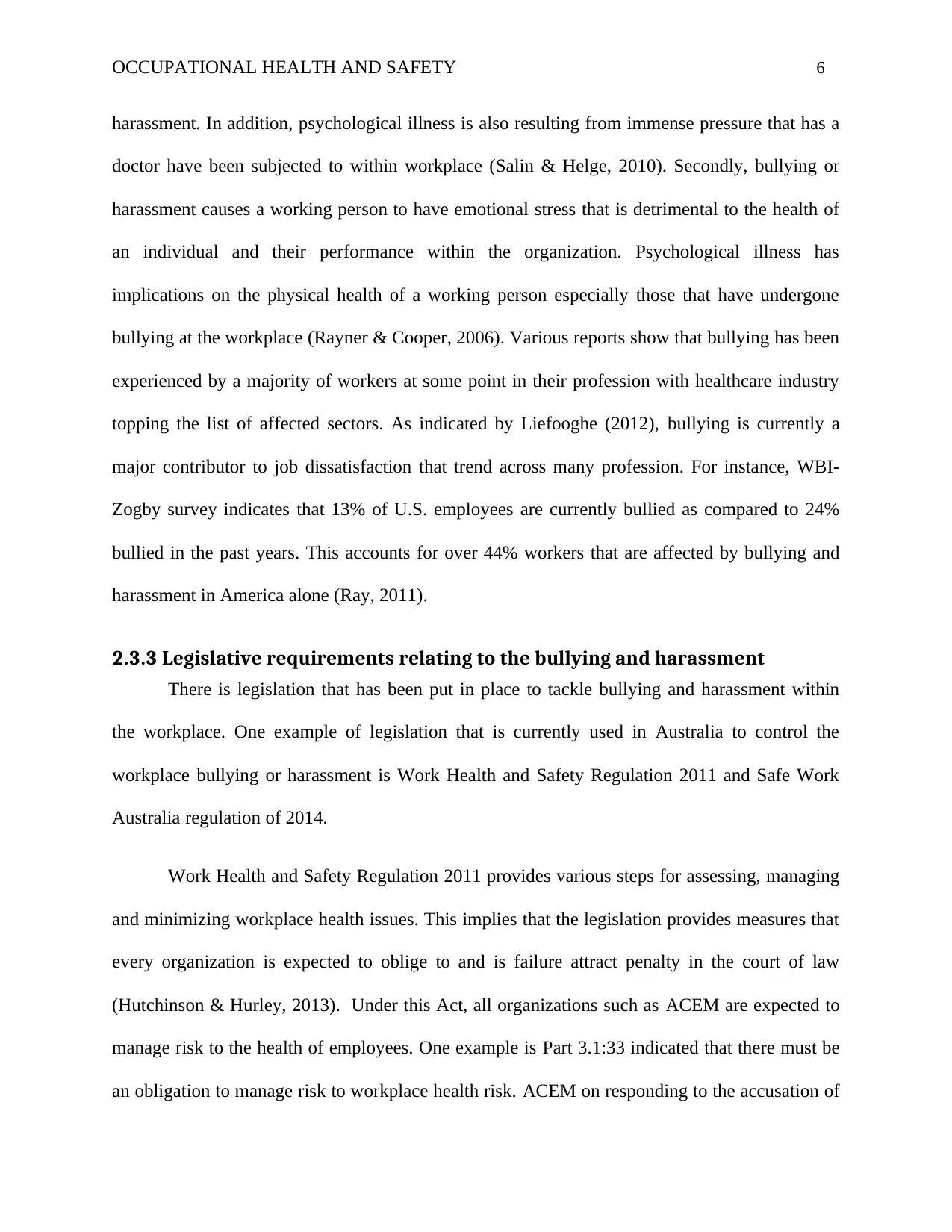
OCCUPATIONAL HEALTH AND SAFETY 6
harassment. In addition, psychological illness is also resulting from immense pressure that has a
doctor have been subjected to within workplace (Salin & Helge, 2010). Secondly, bullying or
harassment causes a working person to have emotional stress that is detrimental to the health of
an individual and their performance within the organization. Psychological illness has
implications on the physical health of a working person especially those that have undergone
bullying at the workplace (Rayner & Cooper, 2006). Various reports show that bullying has been
experienced by a majority of workers at some point in their profession with healthcare industry
topping the list of affected sectors. As indicated by Liefooghe (2012), bullying is currently a
major contributor to job dissatisfaction that trend across many profession. For instance, WBI-
Zogby survey indicates that 13% of U.S. employees are currently bullied as compared to 24%
bullied in the past years. This accounts for over 44% workers that are affected by bullying and
harassment in America alone (Ray, 2011).
2.3.3 Legislative requirements relating to the bullying and harassment
There is legislation that has been put in place to tackle bullying and harassment within
the workplace. One example of legislation that is currently used in Australia to control the
workplace bullying or harassment is Work Health and Safety Regulation 2011 and Safe Work
Australia regulation of 2014.
Work Health and Safety Regulation 2011 provides various steps for assessing, managing
and minimizing workplace health issues. This implies that the legislation provides measures that
every organization is expected to oblige to and is failure attract penalty in the court of law
(Hutchinson & Hurley, 2013). Under this Act, all organizations such as ACEM are expected to
manage risk to the health of employees. One example is Part 3.1:33 indicated that there must be
an obligation to manage risk to workplace health risk. ACEM on responding to the accusation of
harassment. In addition, psychological illness is also resulting from immense pressure that has a
doctor have been subjected to within workplace (Salin & Helge, 2010). Secondly, bullying or
harassment causes a working person to have emotional stress that is detrimental to the health of
an individual and their performance within the organization. Psychological illness has
implications on the physical health of a working person especially those that have undergone
bullying at the workplace (Rayner & Cooper, 2006). Various reports show that bullying has been
experienced by a majority of workers at some point in their profession with healthcare industry
topping the list of affected sectors. As indicated by Liefooghe (2012), bullying is currently a
major contributor to job dissatisfaction that trend across many profession. For instance, WBI-
Zogby survey indicates that 13% of U.S. employees are currently bullied as compared to 24%
bullied in the past years. This accounts for over 44% workers that are affected by bullying and
harassment in America alone (Ray, 2011).
2.3.3 Legislative requirements relating to the bullying and harassment
There is legislation that has been put in place to tackle bullying and harassment within
the workplace. One example of legislation that is currently used in Australia to control the
workplace bullying or harassment is Work Health and Safety Regulation 2011 and Safe Work
Australia regulation of 2014.
Work Health and Safety Regulation 2011 provides various steps for assessing, managing
and minimizing workplace health issues. This implies that the legislation provides measures that
every organization is expected to oblige to and is failure attract penalty in the court of law
(Hutchinson & Hurley, 2013). Under this Act, all organizations such as ACEM are expected to
manage risk to the health of employees. One example is Part 3.1:33 indicated that there must be
an obligation to manage risk to workplace health risk. ACEM on responding to the accusation of
⊘ This is a preview!⊘
Do you want full access?
Subscribe today to unlock all pages.

Trusted by 1+ million students worldwide
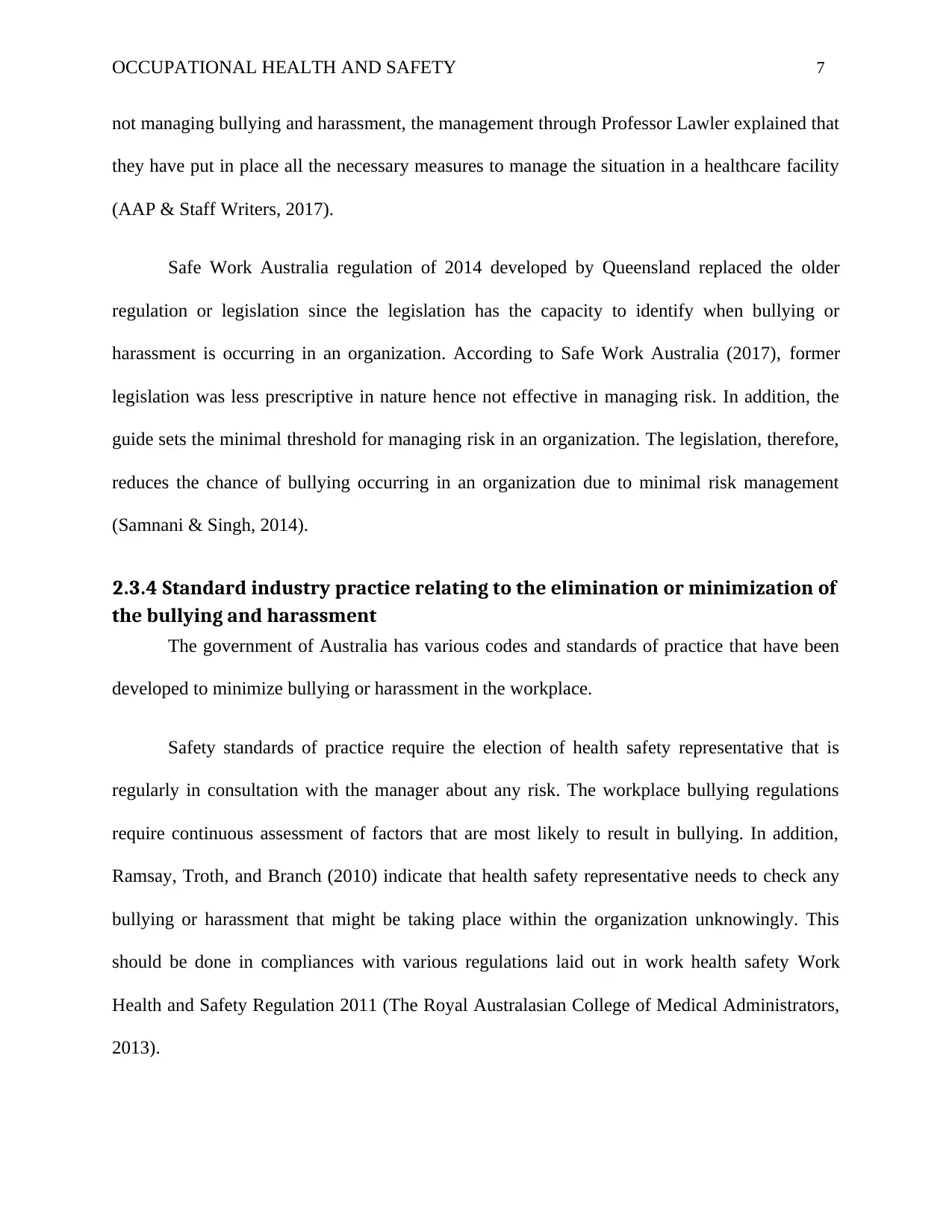
OCCUPATIONAL HEALTH AND SAFETY 7
not managing bullying and harassment, the management through Professor Lawler explained that
they have put in place all the necessary measures to manage the situation in a healthcare facility
(AAP & Staff Writers, 2017).
Safe Work Australia regulation of 2014 developed by Queensland replaced the older
regulation or legislation since the legislation has the capacity to identify when bullying or
harassment is occurring in an organization. According to Safe Work Australia (2017), former
legislation was less prescriptive in nature hence not effective in managing risk. In addition, the
guide sets the minimal threshold for managing risk in an organization. The legislation, therefore,
reduces the chance of bullying occurring in an organization due to minimal risk management
(Samnani & Singh, 2014).
2.3.4 Standard industry practice relating to the elimination or minimization of
the bullying and harassment
The government of Australia has various codes and standards of practice that have been
developed to minimize bullying or harassment in the workplace.
Safety standards of practice require the election of health safety representative that is
regularly in consultation with the manager about any risk. The workplace bullying regulations
require continuous assessment of factors that are most likely to result in bullying. In addition,
Ramsay, Troth, and Branch (2010) indicate that health safety representative needs to check any
bullying or harassment that might be taking place within the organization unknowingly. This
should be done in compliances with various regulations laid out in work health safety Work
Health and Safety Regulation 2011 (The Royal Australasian College of Medical Administrators,
2013).
not managing bullying and harassment, the management through Professor Lawler explained that
they have put in place all the necessary measures to manage the situation in a healthcare facility
(AAP & Staff Writers, 2017).
Safe Work Australia regulation of 2014 developed by Queensland replaced the older
regulation or legislation since the legislation has the capacity to identify when bullying or
harassment is occurring in an organization. According to Safe Work Australia (2017), former
legislation was less prescriptive in nature hence not effective in managing risk. In addition, the
guide sets the minimal threshold for managing risk in an organization. The legislation, therefore,
reduces the chance of bullying occurring in an organization due to minimal risk management
(Samnani & Singh, 2014).
2.3.4 Standard industry practice relating to the elimination or minimization of
the bullying and harassment
The government of Australia has various codes and standards of practice that have been
developed to minimize bullying or harassment in the workplace.
Safety standards of practice require the election of health safety representative that is
regularly in consultation with the manager about any risk. The workplace bullying regulations
require continuous assessment of factors that are most likely to result in bullying. In addition,
Ramsay, Troth, and Branch (2010) indicate that health safety representative needs to check any
bullying or harassment that might be taking place within the organization unknowingly. This
should be done in compliances with various regulations laid out in work health safety Work
Health and Safety Regulation 2011 (The Royal Australasian College of Medical Administrators,
2013).
Paraphrase This Document
Need a fresh take? Get an instant paraphrase of this document with our AI Paraphraser
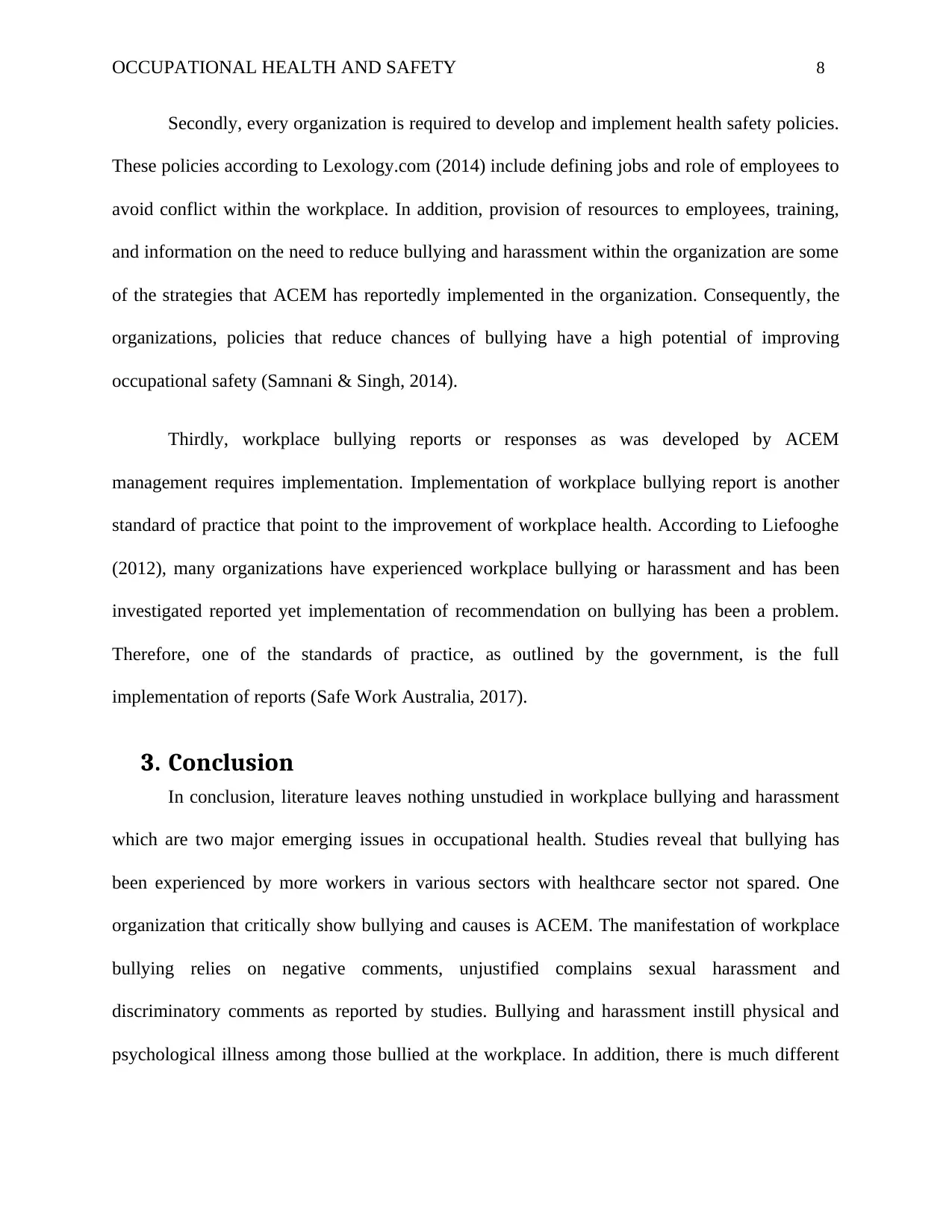
OCCUPATIONAL HEALTH AND SAFETY 8
Secondly, every organization is required to develop and implement health safety policies.
These policies according to Lexology.com (2014) include defining jobs and role of employees to
avoid conflict within the workplace. In addition, provision of resources to employees, training,
and information on the need to reduce bullying and harassment within the organization are some
of the strategies that ACEM has reportedly implemented in the organization. Consequently, the
organizations, policies that reduce chances of bullying have a high potential of improving
occupational safety (Samnani & Singh, 2014).
Thirdly, workplace bullying reports or responses as was developed by ACEM
management requires implementation. Implementation of workplace bullying report is another
standard of practice that point to the improvement of workplace health. According to Liefooghe
(2012), many organizations have experienced workplace bullying or harassment and has been
investigated reported yet implementation of recommendation on bullying has been a problem.
Therefore, one of the standards of practice, as outlined by the government, is the full
implementation of reports (Safe Work Australia, 2017).
3. Conclusion
In conclusion, literature leaves nothing unstudied in workplace bullying and harassment
which are two major emerging issues in occupational health. Studies reveal that bullying has
been experienced by more workers in various sectors with healthcare sector not spared. One
organization that critically show bullying and causes is ACEM. The manifestation of workplace
bullying relies on negative comments, unjustified complains sexual harassment and
discriminatory comments as reported by studies. Bullying and harassment instill physical and
psychological illness among those bullied at the workplace. In addition, there is much different
Secondly, every organization is required to develop and implement health safety policies.
These policies according to Lexology.com (2014) include defining jobs and role of employees to
avoid conflict within the workplace. In addition, provision of resources to employees, training,
and information on the need to reduce bullying and harassment within the organization are some
of the strategies that ACEM has reportedly implemented in the organization. Consequently, the
organizations, policies that reduce chances of bullying have a high potential of improving
occupational safety (Samnani & Singh, 2014).
Thirdly, workplace bullying reports or responses as was developed by ACEM
management requires implementation. Implementation of workplace bullying report is another
standard of practice that point to the improvement of workplace health. According to Liefooghe
(2012), many organizations have experienced workplace bullying or harassment and has been
investigated reported yet implementation of recommendation on bullying has been a problem.
Therefore, one of the standards of practice, as outlined by the government, is the full
implementation of reports (Safe Work Australia, 2017).
3. Conclusion
In conclusion, literature leaves nothing unstudied in workplace bullying and harassment
which are two major emerging issues in occupational health. Studies reveal that bullying has
been experienced by more workers in various sectors with healthcare sector not spared. One
organization that critically show bullying and causes is ACEM. The manifestation of workplace
bullying relies on negative comments, unjustified complains sexual harassment and
discriminatory comments as reported by studies. Bullying and harassment instill physical and
psychological illness among those bullied at the workplace. In addition, there is much different
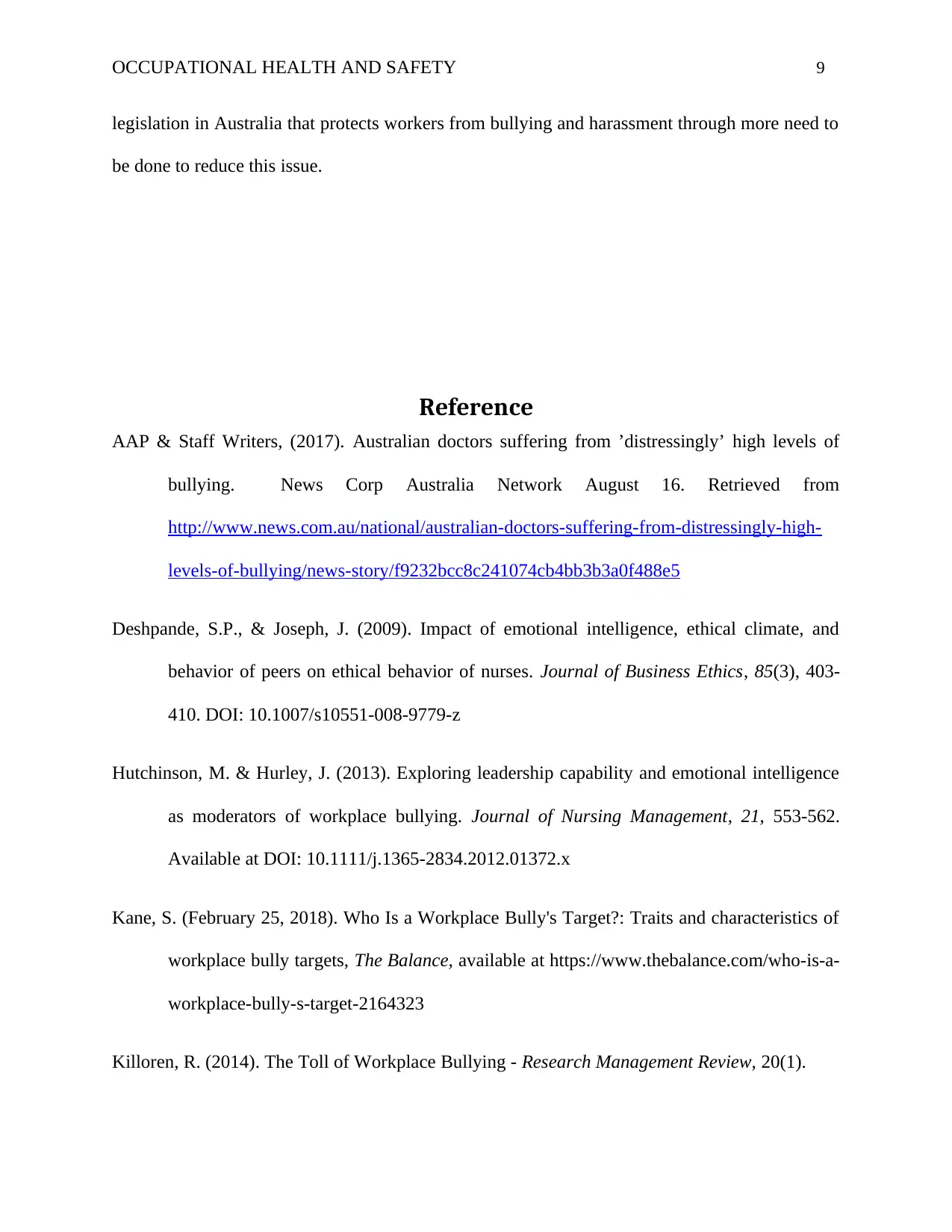
OCCUPATIONAL HEALTH AND SAFETY 9
legislation in Australia that protects workers from bullying and harassment through more need to
be done to reduce this issue.
Reference
AAP & Staff Writers, (2017). Australian doctors suffering from ’distressingly’ high levels of
bullying. News Corp Australia Network August 16. Retrieved from
http://www.news.com.au/national/australian-doctors-suffering-from-distressingly-high-
levels-of-bullying/news-story/f9232bcc8c241074cb4bb3b3a0f488e5
Deshpande, S.P., & Joseph, J. (2009). Impact of emotional intelligence, ethical climate, and
behavior of peers on ethical behavior of nurses. Journal of Business Ethics, 85(3), 403-
410. DOI: 10.1007/s10551-008-9779-z
Hutchinson, M. & Hurley, J. (2013). Exploring leadership capability and emotional intelligence
as moderators of workplace bullying. Journal of Nursing Management, 21, 553-562.
Available at DOI: 10.1111/j.1365-2834.2012.01372.x
Kane, S. (February 25, 2018). Who Is a Workplace Bully's Target?: Traits and characteristics of
workplace bully targets, The Balance, available at https://www.thebalance.com/who-is-a-
workplace-bully-s-target-2164323
Killoren, R. (2014). The Toll of Workplace Bullying - Research Management Review, 20(1).
legislation in Australia that protects workers from bullying and harassment through more need to
be done to reduce this issue.
Reference
AAP & Staff Writers, (2017). Australian doctors suffering from ’distressingly’ high levels of
bullying. News Corp Australia Network August 16. Retrieved from
http://www.news.com.au/national/australian-doctors-suffering-from-distressingly-high-
levels-of-bullying/news-story/f9232bcc8c241074cb4bb3b3a0f488e5
Deshpande, S.P., & Joseph, J. (2009). Impact of emotional intelligence, ethical climate, and
behavior of peers on ethical behavior of nurses. Journal of Business Ethics, 85(3), 403-
410. DOI: 10.1007/s10551-008-9779-z
Hutchinson, M. & Hurley, J. (2013). Exploring leadership capability and emotional intelligence
as moderators of workplace bullying. Journal of Nursing Management, 21, 553-562.
Available at DOI: 10.1111/j.1365-2834.2012.01372.x
Kane, S. (February 25, 2018). Who Is a Workplace Bully's Target?: Traits and characteristics of
workplace bully targets, The Balance, available at https://www.thebalance.com/who-is-a-
workplace-bully-s-target-2164323
Killoren, R. (2014). The Toll of Workplace Bullying - Research Management Review, 20(1).
⊘ This is a preview!⊘
Do you want full access?
Subscribe today to unlock all pages.

Trusted by 1+ million students worldwide
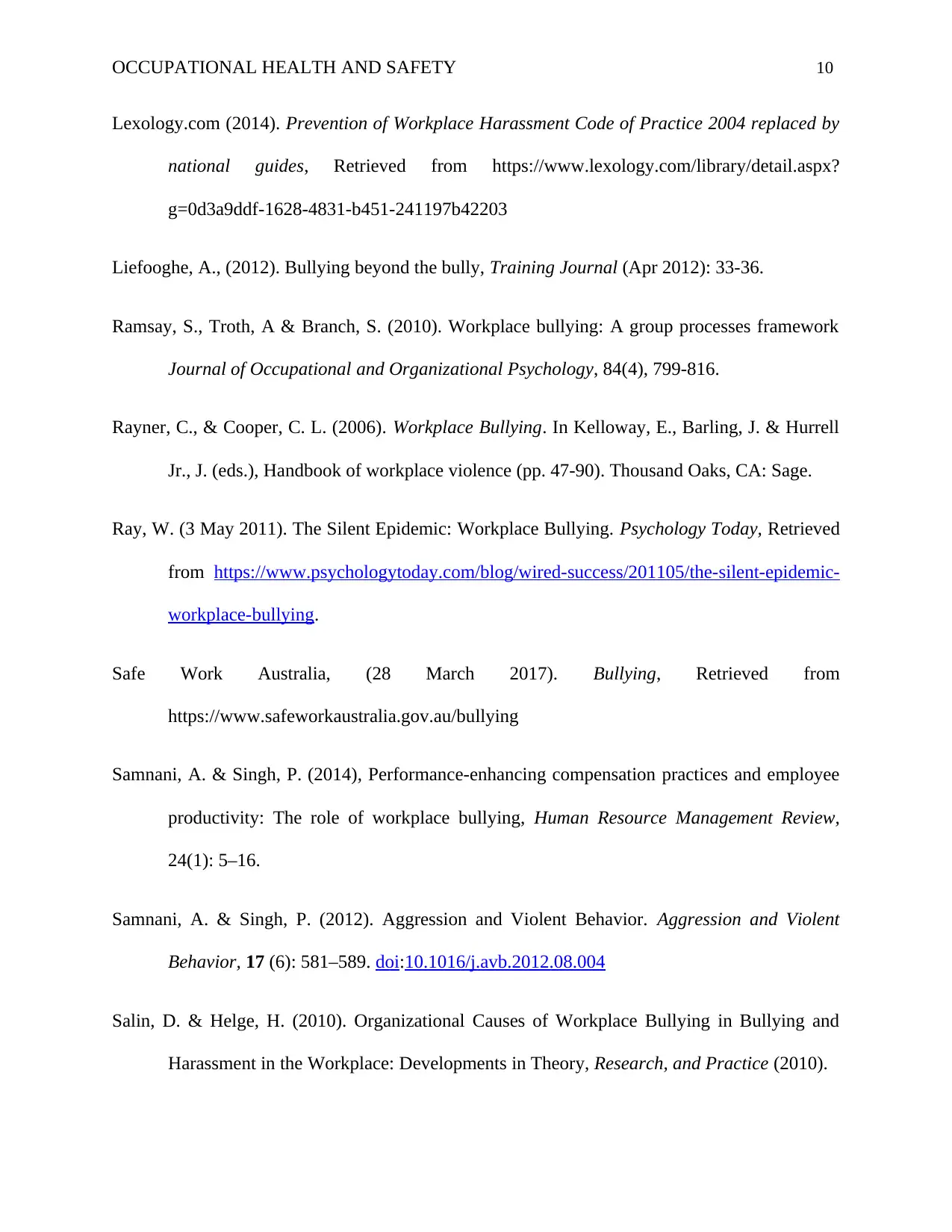
OCCUPATIONAL HEALTH AND SAFETY 10
Lexology.com (2014). Prevention of Workplace Harassment Code of Practice 2004 replaced by
national guides, Retrieved from https://www.lexology.com/library/detail.aspx?
g=0d3a9ddf-1628-4831-b451-241197b42203
Liefooghe, A., (2012). Bullying beyond the bully, Training Journal (Apr 2012): 33-36.
Ramsay, S., Troth, A & Branch, S. (2010). Workplace bullying: A group processes framework
Journal of Occupational and Organizational Psychology, 84(4), 799-816.
Rayner, C., & Cooper, C. L. (2006). Workplace Bullying. In Kelloway, E., Barling, J. & Hurrell
Jr., J. (eds.), Handbook of workplace violence (pp. 47-90). Thousand Oaks, CA: Sage.
Ray, W. (3 May 2011). The Silent Epidemic: Workplace Bullying. Psychology Today, Retrieved
from https://www.psychologytoday.com/blog/wired-success/201105/the-silent-epidemic-
workplace-bullying.
Safe Work Australia, (28 March 2017). Bullying, Retrieved from
https://www.safeworkaustralia.gov.au/bullying
Samnani, A. & Singh, P. (2014), Performance-enhancing compensation practices and employee
productivity: The role of workplace bullying, Human Resource Management Review,
24(1): 5–16.
Samnani, A. & Singh, P. (2012). Aggression and Violent Behavior. Aggression and Violent
Behavior, 17 (6): 581–589. doi:10.1016/j.avb.2012.08.004
Salin, D. & Helge, H. (2010). Organizational Causes of Workplace Bullying in Bullying and
Harassment in the Workplace: Developments in Theory, Research, and Practice (2010).
Lexology.com (2014). Prevention of Workplace Harassment Code of Practice 2004 replaced by
national guides, Retrieved from https://www.lexology.com/library/detail.aspx?
g=0d3a9ddf-1628-4831-b451-241197b42203
Liefooghe, A., (2012). Bullying beyond the bully, Training Journal (Apr 2012): 33-36.
Ramsay, S., Troth, A & Branch, S. (2010). Workplace bullying: A group processes framework
Journal of Occupational and Organizational Psychology, 84(4), 799-816.
Rayner, C., & Cooper, C. L. (2006). Workplace Bullying. In Kelloway, E., Barling, J. & Hurrell
Jr., J. (eds.), Handbook of workplace violence (pp. 47-90). Thousand Oaks, CA: Sage.
Ray, W. (3 May 2011). The Silent Epidemic: Workplace Bullying. Psychology Today, Retrieved
from https://www.psychologytoday.com/blog/wired-success/201105/the-silent-epidemic-
workplace-bullying.
Safe Work Australia, (28 March 2017). Bullying, Retrieved from
https://www.safeworkaustralia.gov.au/bullying
Samnani, A. & Singh, P. (2014), Performance-enhancing compensation practices and employee
productivity: The role of workplace bullying, Human Resource Management Review,
24(1): 5–16.
Samnani, A. & Singh, P. (2012). Aggression and Violent Behavior. Aggression and Violent
Behavior, 17 (6): 581–589. doi:10.1016/j.avb.2012.08.004
Salin, D. & Helge, H. (2010). Organizational Causes of Workplace Bullying in Bullying and
Harassment in the Workplace: Developments in Theory, Research, and Practice (2010).
Paraphrase This Document
Need a fresh take? Get an instant paraphrase of this document with our AI Paraphraser
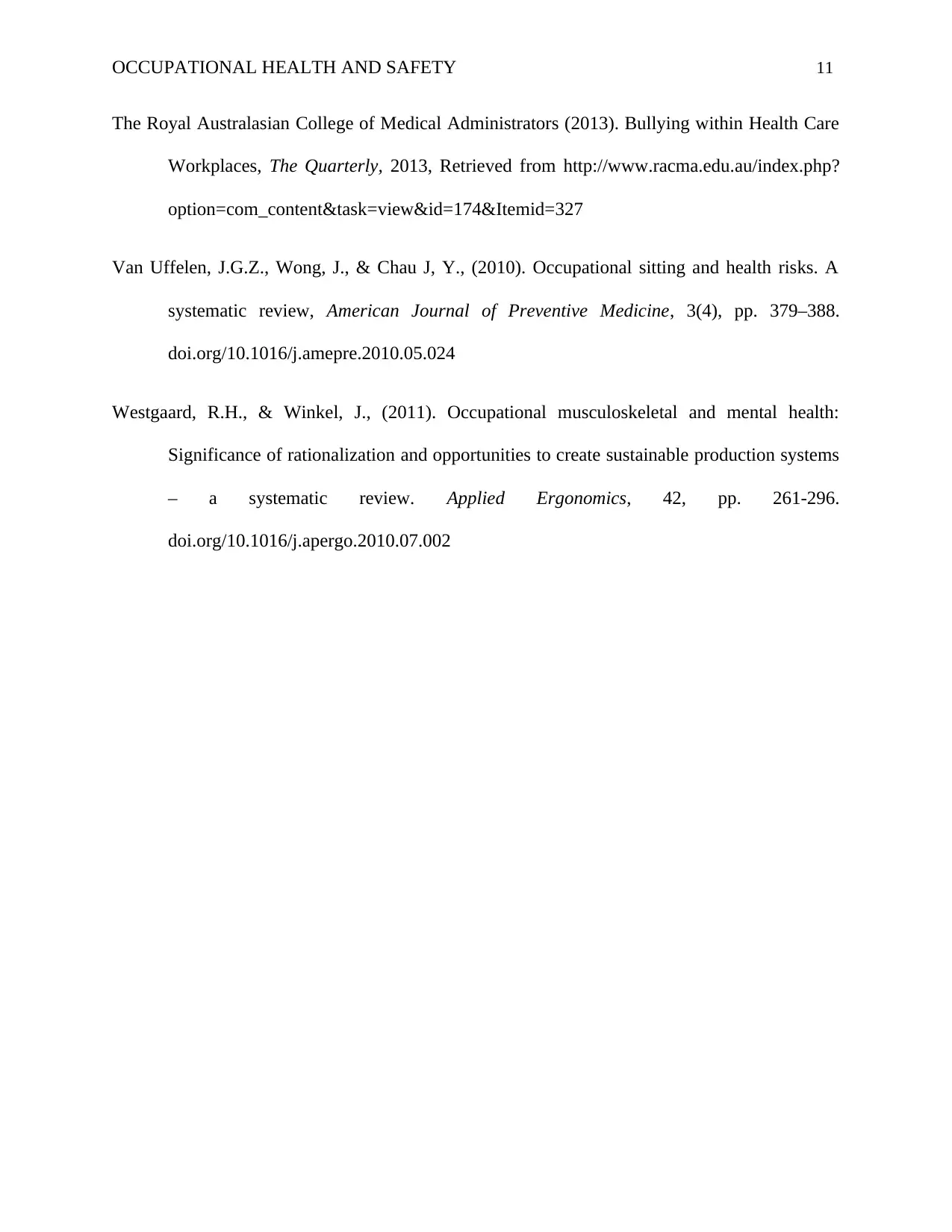
OCCUPATIONAL HEALTH AND SAFETY 11
The Royal Australasian College of Medical Administrators (2013). Bullying within Health Care
Workplaces, The Quarterly, 2013, Retrieved from http://www.racma.edu.au/index.php?
option=com_content&task=view&id=174&Itemid=327
Van Uffelen, J.G.Z., Wong, J., & Chau J, Y., (2010). Occupational sitting and health risks. A
systematic review, American Journal of Preventive Medicine, 3(4), pp. 379–388.
doi.org/10.1016/j.amepre.2010.05.024
Westgaard, R.H., & Winkel, J., (2011). Occupational musculoskeletal and mental health:
Significance of rationalization and opportunities to create sustainable production systems
– a systematic review. Applied Ergonomics, 42, pp. 261-296.
doi.org/10.1016/j.apergo.2010.07.002
The Royal Australasian College of Medical Administrators (2013). Bullying within Health Care
Workplaces, The Quarterly, 2013, Retrieved from http://www.racma.edu.au/index.php?
option=com_content&task=view&id=174&Itemid=327
Van Uffelen, J.G.Z., Wong, J., & Chau J, Y., (2010). Occupational sitting and health risks. A
systematic review, American Journal of Preventive Medicine, 3(4), pp. 379–388.
doi.org/10.1016/j.amepre.2010.05.024
Westgaard, R.H., & Winkel, J., (2011). Occupational musculoskeletal and mental health:
Significance of rationalization and opportunities to create sustainable production systems
– a systematic review. Applied Ergonomics, 42, pp. 261-296.
doi.org/10.1016/j.apergo.2010.07.002
1 out of 11
Related Documents
Your All-in-One AI-Powered Toolkit for Academic Success.
+13062052269
info@desklib.com
Available 24*7 on WhatsApp / Email
![[object Object]](/_next/static/media/star-bottom.7253800d.svg)
Unlock your academic potential
Copyright © 2020–2025 A2Z Services. All Rights Reserved. Developed and managed by ZUCOL.





